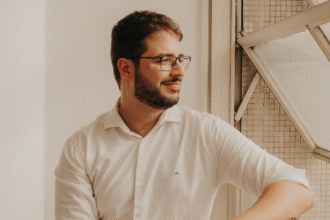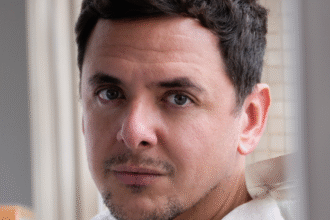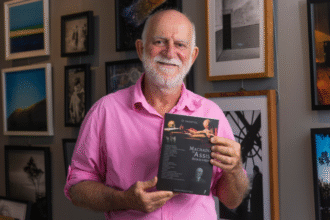Clara Haddad, the renowned Portuguese-Brazilian storyteller, who is widely admired in both Brazil and Portugal, celebrates her 25 years as a word artist. On November 25th, the Memorial da América Latina will become the special stage for this celebration, marking two and a half decades of Clara Haddad’s dedication to the art of narration.
The program for this memorable day will include the participation of Lenice Gomes, Jonas Ribeiro and Cidinha Pardini, as well as several interventions by narrators and artists from different parts of the world, who will share their experiences through a big screen, paying tribute to Clara’s unique contribution Haddad for the oral narrative and establishing a special connection between Brazil and Portugal.
Among his notable achievements is the founding of the “Escola de Narração Itinerante”, in Portugal, in 2006, where he transmitted the art of words to countless people who today tell stories professionally. In 2015, she was recognized as the best Portuguese-speaking narrator in Europe. Furthermore, in 2020, she was awarded the Baobá Trophy, known as the “Oscar of Narrators and Reading Mediators” in Brazil, in recognition of her exemplary career. Another highlight of this event will be the launch of the book “A Vehinha e o Porco”, written by Clara Haddad and published in English and Portuguese by Telos Editora. The book features illustrations by Colombian artist Canizales.
To end this celebration with a flourish, Clara Haddad will enchant the audience with a special show, sharing her fascinating stories and accompanied by the talented musician Ramiro Marques. This presentation promises to be a moment of pure magic, capable of captivating everyone present. This event is a well-deserved tribute to an artist who dedicated her life to promoting oral storytelling and disseminating the world’s cultural riches, especially Portuguese-Brazilian culture, through the stories she shares.
How did your journey into oral storytelling begin, and what motivated you to choose this artistic path?
I started in 1998 as a year-end decision. I have a background in Performing Arts and TV and Cinema, but I felt I needed to change my career by doing something that would connect me more closely with the public. I went back to the stories I heard as a child through my grandmother’s voice. It was a difficult transition, as they are similar arts, but I felt it made more sense, I wanted to work on art in a more organic way. What enchants me about the language of storytelling is that the narrator has the possibility of playing all the characters, without ceasing to be him reporting the events. We can change our voice and even our gestures, but we never stop being ourselves when telling a story. In the art of theater, we shed our skin and create a life that is not ours and tell it through the character’s eyes.
When founding the Escola de Narração Itinerante in Portugal, what was the vision behind this project and how did it impact the dissemination of the art of narration in the region?
I wanted to offer the opportunity for a variety of narrator voices to the Portuguese public. The idea of the narration school was to give space to create and listen to stories. A space for serious study and committed to ethics in the profession, with the multiplicity of possible styles to narrate. When I arrived in Portugal, in 2005, there was a small movement of narrators and it was centered on 3 or 4 artists and a festival. And, after the emergence of the itinerant narration school, in 2006, the events I organized, especially in the north of the country, such as story nights for adults, storytelling marathons in various spaces and bookstores and festivals, saw a significant increase in the audience listening to this art. and consequently of people who became interested in the profession, studying and learning more about the subject and subsequently taking the step to become professional. I know the importance of this and I am happy with the trajectory of people who have become co-workers and travel around Portugal at various events and even in other countries. Teaching this art also means making room for the new. I believe this is the way. Open doors and don’t create walls.
Receiving the title of best Portuguese-language narrator in Europe in 2015 must have been a significant honor. Can you share a little about this recognition and its importance for you?
Recognition is always good, but it’s not what moves me. I don’t narrate for the awards or to have titles. I narrate stories because I love doing it and I feel absolutely surrendered to the moment of the narrative. And like the air I breathe and my way of being everything in life. I believe it is a social function, to disseminate the culture and art of various peoples through words so that this knowledge is not lost. When I received the award in Belgium, I wasn’t even expecting it and didn’t even know I was competing. I found out from the audience at the end of my show that I had been chosen. Upon hearing the news, of course I was filled with joy and felt very honored to represent Portuguese-speaking artists. Without a doubt, it was a unique moment in my career.
What does it mean to you to receive the Baobá Trophy in 2020, known as the “Oscar for Storytellers and Reading Mediators”?
Being honored for my trajectory, for taking Brazil’s name to the world and exchanging culture with Portugal and other countries is a very important and significant recognition for me. Above all, for being alongside people I admire and who were also recognized by this trophy. This gives me the certainty that I am on the right path.
His new book “A Vehinha e o Porco” promises to be a charming work. Can you tell us a little about the inspiration behind this book and what readers can expect?
This is a retelling of a traditional English story that I heard as a child. I loved the “old lady”, but I always wanted to make my own version. And now, after so long with this story in my heart, I decided to write it. It was fun to reread it because I always liked humorous and cumulative stories. In my story the ending is unexpected and will amuse readers a lot.

What was the collaboration process like with illustrator Canizales to create the images that complement his narrative in “A Vehinha e o Porco”?
This process was different from the others. I didn’t make any suggestions to the illustrator. In my previous works, I was involved in all phases, from selecting the artist to defining the cover and illustrations, as the first publication took place in Portugal by Fábrica das Histórias, which is my small independent publisher and the rights were acquired by Telos for publication in Brazil. However, in the case of the “Old Lady and the Pig” book, Telos will publish the work for the first time. I followed the process as an author and focused more on the questions in the text. The edition was led by the Brazilian editor, Erivan Gomes.
The event at the Memorial da América Latina marks an important milestone in his career. What are your expectations and feelings as you celebrate these 25 years of contributions to the art of narration?
I don’t know about expectations, but the feeling is gratitude for following a path that I chose for myself and that many people thought was crazy! But what is certain is that there are 30 years of artistic career and 25 years of very successful storytelling, more than 19 countries visited and an audience of more than 500 thousand people and that is an achievement: to live on art and what we choose and we love doing it. At the memorial, what I want is to make an excellent presentation and present the new book to the Brazilian public with a lot of joy and energy.
You mentioned that the special show will be accompanied by musician Ramiro Marques. How does music contribute to your way of telling stories and what can the public expect from this musical moment?
The partnership with Ramiro is great because he knows how to create and introduce music at the right time in the narrative and everything flows very well! Creating a sound environment for the narrative moment. There is harmony in our work and when there is this connection between music and words everything becomes even more magical.
Looking to the future, what are the next steps or projects you would like to undertake in the area of oral storytelling?
I have a new project that is collective mentoring for people who want to tell stories and learn this craft or improve their performance in the area. This mentoring is called “Confraria da Palavra” and will also be officially launched on November 25th. The project is a registered and pioneering brand as it is the first storytelling and literature club worldwide with monthly sessions that will start in January next year.
How do you see the role of oral storytelling in preserving and sharing cultural traditions, especially at the intersection between Brazilian and Portuguese cultures?
Fundamental! Stories are the soul of a people, if we stop sharing our stories we lose our memory and the memory of who we are! Brazilian and Portuguese culture has meeting points, as well as other cultures, as everything starts from the same basis: human feelings and this is the same for everyone! It doesn’t matter if you’re Brazilian, Portuguese, Japanese, Finnish… there are characteristics of each place, but what our human feeling is doesn’t change. We will always have feelings of fear, love, pain, sadness, joy, hope and it is through our life and literary stories that we share this.
Follow Clara Haddad in Instagram





